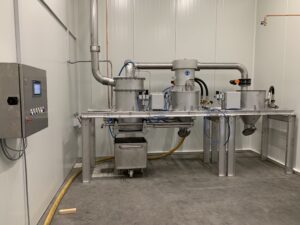Upgrading by-product streams – mechanically separated meat
In slaughterhouses or specialists in mechanically separated meat, the by-product stream can be upgraded by separating the bones from the meat. This is typically done by meat separators. The meat is referred to as Mechanically separated meat (MSM), mechanically recovered/reclaimed meat (MRM), or mechanically deboned meat (MDM). It is a paste-like meat product produced by forcing pureed or ground beef, pork, mutton, turkey or chicken, under high pressure through a sieve or similar device to separate the bone from the edible meat tissue. For companies that process this meat (it may be slaughterhouses or companies specializing in the production of MSM), it is a start to turn waste into profit.
MSM may be used in meat preparations that still need to undergo heat treatment before consumption (by the user himself) and in meat products (e.g., snacks). If the MSM does not meet the microbiological criteria, then MSM can only be used for ‘meat products’. The higher the microbiological quality of MSM, the more applications there are for further processing.
The product to be processed must be transported towards the MSM machine in a hygienical way.
Transport possibilities are belt conveyors or meat tubs. However all transport methods need to be hygienically cleaned after usage. If not, the transported products can be a reason that the microbiological criteria cannot be guaranteed.
Hygienic vacuum transport of chicken carcasses
The usage of meat tubs looks simple but you disrupt the continuous production of MSM meat, the tubs need to be stored in the deboning department, transported to the MSM room, stored, emptied and cleaned.
Belt conveyors might be a solution but the distance between the two departments can be more than 50 meters. If so, this requires multiple belt conveyors, with multiple transfers and the belt conveyors should be installed at a height of approx. 3.000 mm to eliminate collisions. The belts need to be cleaned on a daily basis, the return path of the belt should also be cleaned. A drip pan over the full length should be installed to avoid drippings onto the production equipment.
Vacuum transport is probably the best solution to eliminate the disadvantages of above-mentioned methods. But cleaning is a challenge.
Demo installation at HYTT workshop
 Over the years we have gained a lot of experience about which products can be transported with vacuum through a stainless-steel tube with diameters of 150mm or 200mm over a distance of some 150 metres. We have developed our knowledge based on the hundreds of vacuum transport installations operating worldwide in pig slaughterhouses, poultry slaughterhouses, cattle slaughterhouses, vegetable processing companies, fruit processing companies, fish processing companies, professional kitchens and industrial bakeries.
Over the years we have gained a lot of experience about which products can be transported with vacuum through a stainless-steel tube with diameters of 150mm or 200mm over a distance of some 150 metres. We have developed our knowledge based on the hundreds of vacuum transport installations operating worldwide in pig slaughterhouses, poultry slaughterhouses, cattle slaughterhouses, vegetable processing companies, fruit processing companies, fish processing companies, professional kitchens and industrial bakeries.
Since we have established our own vacuum transport system inhouse the development and applications have skyrocketed. We have tested many different products ranging from plastics, beansprouts, smoked mackerel, bread, cookies, potatoes, vegetables, cooked rice, crisps, frozen fries to chicken carcasses.
For an existing customer of HYTT we have tested the transportation of chicken carcasses. The goal was to determine the size of the system based on a capacity of 25.000 BPH speed.
Several tests were successfully conducted on the transportation of chicken carcasses. Our test team is ready for you!
Cleaning
The real challenge is how the pipes can be hygienically and efficiently cleaned on a daily basis.
How can the microbiological demands set out by Verordening/Regulation (EG) nr. 852/2004 be met?
What other technologies than CIP systems can be applied? HYTT has developed a cleaning and disinfection method to clean the pipes. We will elaborate on this topic soon.
Do you want to know what benefits hygienic internal transport can have for your food processing plant?
Interested in general about what products and how to transport check this animation of a vacuum transport system for the poultry sector. Or check further information on our website at: https://hytt.eu/poultry-processing-industy/
Interested in an interview with our appreciated customer Bell & Evans: https://hytt.eu/vacuum-transport-system-food-plant-2022/
Request Bell & Evans case study. Please contact us at https://hytt.eu/contact/
HYTT have developed a cleaning and disinfection method and device for cleaning of the suction points and piping. We will inform you further soon or contact us.